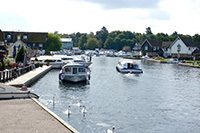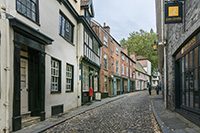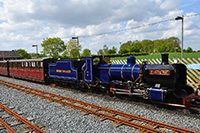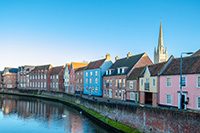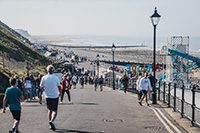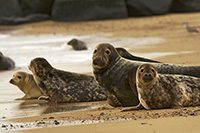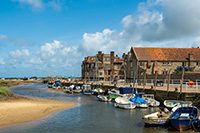Visit the Norfolk Coast
Best of the Norfolk Coast
The Norfolk coast is one of the most stunning parts of the United Kingdom, with a coastline to die for. Steeped in hundreds of thousands of years of history, fantastic beaches and stunning nature, the Norfolk coast is a wonderful place to live or take a much needed break in.
The Norfolk coast: The holiday destination of millions!
So many of us have enjoyed holidays on the Norfolk coast and still love returning for more. In an age where many seek sunnier destinations in foreign parts, the Norfolk coast still holds very fond memories of childhood holidays for many people in this country, drawing them back year on year to enjoy the wonders of this beautiful coastline.
Where is the Norfolk coast?
The Norfolk district is an administrative area in Norfolk England which stretches from somewhere between Winterton Beach and Horsey Gap, to the middle of Holkham Gap.
The Norfolk coast is actually a geographical area which stretches from Winterton-on-Sea all the way round to the Wash.
The Norfolk coast stretches for over seventy miles from Winterton-on-Sea in the east to King’s Lynn which lies on the Wash, in the west.
The Norfolk coast is unique
The Norfolk coast has a part which is classed as an Area of Outstanding Natural Beauty. This part of the Norfolk coast consists of long and deep sandy beaches, traditional seaside towns, soft glacial cliffs, salt marshes, shingle ridges and sand dunes, which, in places, are all that separates the North Sea from the famous and beautiful Norfolk Broads.
Along parts of the Norfolk coast, fossils have been found that date back over one million years, and in other places, the flora and fauna are the most diverse of anywhere else in England.
Attractions of the Norfolk coast
Why not visit Blakeney? This is a charming little coastal village on the Norfolk coast and is part of the area of outstanding natural beauty. It has plenty of fascinating history, its very own nature reserve and a jaw dropping beautiful watery landscape for you to explore.
The Blakeney Point National Nature Reserve is home to England’s largest colony of Atlantic Grey seals, which have become one of the most popular attractions on the Norfolk coast.
As one of the most popular Norfolk coast destinations, Blakeney can be quite busy during the summer months, but this just adds to the vibrant nature of this Norfolk coast village. It is a fantastic crabbing location, and one of the best places to take boat trips out to Blakeney Point on seal-watching tours.
Should you crave somewhere a little quieter, walk the sea wall between Blakeney and Morston Quay and enjoy the sweeping views of muddy creeks, moored boats and a rich variety of seabirds, some of which are rarely seen anywhere else apart from the Norfolk coast.
Cromer on the Norfolk coast
A visit to the Norfolk coast wouldn’t be the same without a visit to Cromer. This famed Norfolk coast town is home to the Victorian Cromer pier, the delicious and world famous Cromer Crab and a strong connection with the sea through the Royal National Lifeboat Institute.
Cromer is the perfect Norfolk seaside town for a family holiday and also makes a great base from which to explore the rest of the Norfolk coast.
Unlike many coastal towns, fairground rides of amusements are not the order of the day in Cromer, which is probably why it is such a popular place to visit. There are however lots of things to do in Cromer to keep everyone entertained, whether you’re planning a weekend break, family holiday or day trip, Cromer is a part of the Norfolk coast that really is worth a visit.
Walking along the Norfolk coast
The Norfolk coast boasts the most popular of the walking trails in Norfolk. The Norfolk coast path runs from Hunstanton in West Norfolk to Sea Palling on the northeast Norfolk coast, through the stunning landscape of the Norfolk coast area of outstanding natural beauty.
You can discover coastal treasures walking the path, through sand dunes, around salt marshes, along gorgeous golden beaches and over cliffs, including the famous ice-age Beeston Bump that is situated near Sheringham.
Watch the wonderful array of sea birds, and marvel at the seals in the North Sea. The Norfolk coast path takes you to quaint little villages and seaside resorts along the way. There are also some superb pubs along the way if you develop a thirst from all that walking.
Holkham Hall and Holkham Beach on the Norfolk coast
A really great destination for a day out on the Norfolk coast is Holkham. The small village is fortunate enough to have one of Norfolk’s best stately homes, Holkham Hall, the fabulous Holkham Beach, and Holkham National Nature Reserve.
Holkham Hall is an 18th century Palladian masterpiece with a tranquil walled garden surrounded by stunning and expansive parkland that is home to a herd of beautiful Fallow deer.
Holkham Beach is enormous by any standard and often considered to be the best beach on the Norfolk coast. Surprisingly, even during the summer months, you can find a quiet spot here. Be prepared for a thirty minute walk to get to the sands through the pine woods, but once there, you’ll agree that it was worth the walk.
The tide lines, sand dunes and many intriguing creeks, which make up Holkham’s nature reserve are perfect for exploring, making this part of the Norfolk coast truly memorable.
Bird watching on the Norfolk coast
Norfolk Wildlife Trust Cley Marshes is the county’s oldest and best-known nature reserve and today, Cley and Salthouse Marshes is one of the country’s most popular bird watching sites, attracting more than 110,000 bird watchers and thousands of birds each year.
Among the rarest birds to be spotted has been a white-crowned sparrow from North America, a Pacific swift, a red-necked stint from Asia and a rock sparrow from southern Europe.
Although there are many species of interest using the site in summer and winter, spring and autumn are undoubtedly the best times for rarer birds to be seen in this naturally diverse part of the Norfolk coast.
The location boasts six hides that give fantastic views across pools and scrapes that are specially managed to attract breeding and passage birds.
The visitor centre features interactive interpretation, regularly changing exhibitions, and a well-stocked gift and book shop, there is also a large café which serves local produce and offers panoramic views over the marshes. If you are into bird watching, there really is no better way to enjoy the North Norfolk coast than here.
The Seals at Winterton-on-Sea Beach
There aren’t many places in the United Kingdom where you can see wild seals on a beach, but we’re lucky to have several such places on the Norfolk coast.
Winterton Beach is at the further point south of the Norfolk coast and is a stunning three-mile stretch of sandy beach, backed by the Winterton Dunes National Nature Reserve, home to some of the finest sand dunes in Norfolk.
At the northern end of Winterton Beach is Horsey Beach, home to an Atlantic Grey seal colony. You can see the seals swimming all along Winterton beach year-round, as they pop up their heads to check out what’s happening on the beach.
In winter, around late November to early December, the female seals come onto the beach at Winterton to give birth to their pups. Seals come ashore a full twenty four hours prior to actually giving birth, so you may even be lucky enough to witness this actually happening.
You should be aware that you are requested not to walk on the beach from November to January to prevent the seals from being disturbed, but you can
see the seals and their pups from the dunes and roped-off viewing areas. Dog walkers must keep their pets on a lead to protect the seals, but also to keep the dogs safe, as an angry and protective mother seal could seriously injure a dog if it strayed too close to her or her young. You should also be aware that the seal pups cannot go into the sea for about sixteen to twenty one days after they are born, as their coats are not yet waterproof. When they have their new coat, they can venture out to sea with their mother.
During the breeding season, there are Volunteer Wardens from Friends of Horsey Seals helping to make sure the seals are allowed to give birth and look after their young in peace, and they are a great source of knowledge about the colony and seal behaviour.
Fossil treasures on the North Norfolk coast
The Deep History Coast is made up of over twenty miles of the North Norfolk coast from Weybourne to Cart Gap.
This part of the North Norfolk coast is where the earliest evidence of humans in Britain have been found with million-year-old footprints, alongside the United Kingdom’s biggest mammoth skeleton remains and a 500,000 year old flint hand axe.
Exploring the Deep History Coast is a fascinating and fun day out for families, with lots of activities to help you understand the thousands of years of history the North Norfolk coast has to offer.
You can go fossil hunting along the beautiful beaches between Weybourne and Cart Gap, and following the Discovery Trail to read fascinating information that has been posted along the way.
A favourite activity on this part of the North Norfolk coast is to go rock-pooling and fossil hunting at West Runton Beach, where the Steppe mammoth skeleton was found, or at Happisburgh Beach, where the first footsteps were discovered.
It’s quite common to find fossils along these beaches, ranging from belemnites to hyena coprolites. The best time to hunt is after a high tide or heavy rainfall.
What better way to enjoy all the delights that the North Norfolk coast has to offer? The list of things to do on the North Norfolk coast is virtually endless, but this should give you a little taster for your next visit to this rich and beautiful piece of England.
